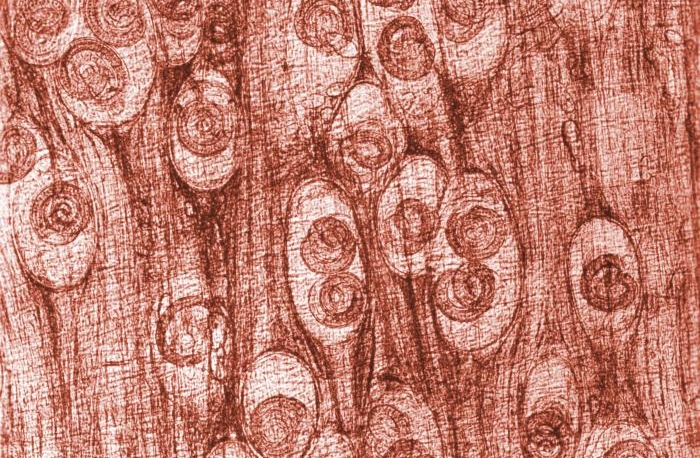As we officially reach the one-month mark of our summer series, “Shedding Light on NTDs”, we hope you are gaining insight and increasing your awareness about diseases that are affecting the most vulnerable populations around the globe. This week, we are going to be discussing Onchocerciasis, a neglected tropical disease commonly referred to as “River Blindness”. The disease is caused by a parasitic worm, Onchocerca volvulus, which is spread through the bite of the Simulium blackfly [1]. The disease’s name comes from the flowing rivers that serve as breeding grounds for the blackfly and from the ultimate blindness that arises from an untreated infection.
Humans contract the parasite when the fly bites and deposits infective larvae into the skin [2]. As the human body reacts to the parasite, nodules form around the larvae, which protects them from host responses [2]. The larvae complete their life cycle in the human body, maturing into worms that can produce thousands of new larvae daily [2]. Shockingly, adult worms can survive for up to 15 years in the human body [2]. As larvae move through the body, host responses react to their presence and cause inflammation, rashes and discomfort [2]. When the larvae reach the eye and optic nerve, severe damage can occur. Initially, lesions on the cornea can occur, but are reversible with treatment. However, inflammation around the optic nerve, caused by death of larvae, can cause peripheral vision loss and may lead to blindness [2].
Transmission of River Blindness usually does not occur from a single blackfly bite; more often it requires numerous bites. However, for those living in the rural communities where blackfly exposure is high, there is a great risk of disease without proper protection from blackflies. Worldwide, 120 million people are at risk of contracting Onchocerciasis, and 99% of those infected live in 31 African countries [3]. In 1975, the Onchocerciasis Control Programme (OCP) in West Africa was created and they were able to effectively eliminate the disease in 10 of the 11 countries that it operated in through mass administration of medication and health education [4]. Furthermore, through the vigilant work of the World Health Organization (WHO), OCP and their partners, between 2013 and 2016, four countries were verified free of River Blindness, including Guatemala, Colombia, Ecuador and Mexico [3].
Blindness due to Onchocerciasis is the fourth leading preventable cause of blindness around the world, after cataract, glaucoma and trachoma [4]. This blindness furthers the cycle of poverty as those who are affected are often not able to work, creating a social stigma against their condition and their status in the community. Additionally, social isolation is not uncommon amongst those with severe skin scarring from nodules and inflammation due to the stigma associated with deformities caused by infection [4]. The only way to help the communities most affected by the disease is through targeted efforts for insect control and effective medical treatments.
On June 13th, 2018, the United States Food and Drug Administration (FDA) approved moxidectin as the first new drug in over twenty years for the treatment of River Blindness [5, 6]. This monumental decision is a game-changer for how the public health community works to eliminate the disease and gives new hope for future drugs aiming to treat neglected tropical diseases. The only drug currently in use is Ivermectin, which has greatly reduced the disease’s presence in endemic regions but is not effective enough to reduce the global burden of River Blindness [6]. Public health officials are optimistic that this new drug will bring us one step closer to eliminating River Blindness once and for all.
Sources:
[1] https://www.cdc.gov/parasites/onchocerciasis/gen_info/faqs.html
[2] https://www.cdc.gov/parasites/onchocerciasis/disease.html
[3] http://www.who.int/onchocerciasis/en/
[4] http://www.who.int/apoc/onchocerciasis/disease/en/
[5] https://www.accessdata.fda.gov/scripts/cder/daf/index.cfm?event=overview.process&applno=210867
[6] http://www.who.int/tdr/news/2018/moxidectin-approved-as-treatment-for-river-blindness/en/

